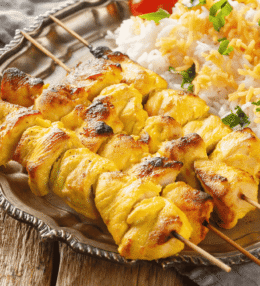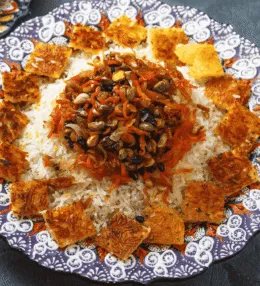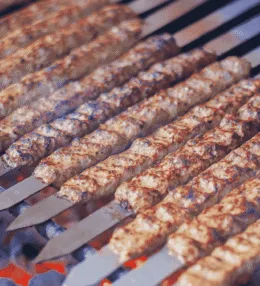
- View
Table of Contents
ToggleVietnamese dining thrives on connection, and few dishes embody this spirit quite like lẩu. This communal hotpot brings people together around a simmering cauldron of aromatic broth, where everyone cooks their own ingredients and shares from the same pot.
Lẩu isn’t just a meal; it’s an experience that unfolds over hours of conversation, laughter, and reaching across the table with chopsticks. The bubbling broth sits at the centre, inviting diners to add fresh vegetables, seafood, meat, and noodles as they please.
What makes lẩu special is its flexibility and inclusiveness. There’s no rigid structure or formal presentation. Instead, you get a relaxed, interactive meal where everyone participates in the cooking process, creating their own perfect bites throughout the evening.
From family gatherings to celebrations with friends, lẩu has become synonymous with togetherness in Vietnamese culture. The dish adapts to every season, occasion, and regional preference, making it endlessly varied yet comfortingly familiar no matter where you encounter it.
Want to dive deeper into Vietnamese Cuisine? Don’t miss our post on 30 Traditional Vietnamese Foods to Try
What Is Lẩu?
Lẩu refers to Vietnamese hotpot, a cooking method where a pot of simmering broth sits on a portable burner at the dining table. Diners add raw ingredients to the broth, cooking them briefly before fishing them out to eat with rice or noodles.
The setup typically includes a central pot filled with flavoured broth, surrounded by plates of raw ingredients waiting to be cooked. These might include thinly sliced beef, prawns, squid, fish balls, leafy greens, mushrooms, and various types of noodles arranged attractively on serving platters.
Each person receives their own bowl, dipping sauce, and chopsticks. You select ingredients from the communal platters, drop them into the bubbling broth, and retrieve them once cooked. The timing becomes instinctive after a few rounds, though gentle guidance from experienced diners helps newcomers.
Regional variations abound throughout Vietnam. The south favours sweet and sour broths with pineapple and tamarind. Central regions lean towards spicier versions with lemongrass and chilli. Northern styles often feature simpler, clearer broths that allow ingredient flavours to shine through.
Unlike individual portions served at once, lẩu encourages a leisurely pace. You cook small amounts at a time, chatting between bites, and the meal naturally extends as the broth grows richer and more complex from all the ingredients that have passed through it.
Ingredients and Taste
The broth forms lẩu’s foundation, and its character varies widely depending on regional style and personal preference. Common bases include chicken stock, seafood broth, or tom yum inspired versions fragrant with lemongrass, galangal, and lime leaves for aromatic depth.
Some versions use coconut water as a base, creating a subtly sweet broth that pairs beautifully with seafood. Others incorporate fermented ingredients like mắm or shrimp paste, producing intensely savoury broths with remarkable umami complexity that develops further throughout the meal.
Protein selections typically include thinly sliced beef or pork, fresh prawns, squid, clams, fish fillets, and various processed items like fish balls or prawn cakes. The thin slicing ensures everything cooks quickly in the simmering broth, maintaining tenderness.
Vegetables play an essential role, adding colour, texture, and nutrition. Water spinach, morning glory, bok choy, cabbage, and various mushrooms appear frequently. Bean sprouts, okra, and tomatoes contribute different textures, whilst herbs like Thai basil, coriander, and sawtooth coriander add freshness.
Dipping sauces personalize each bite. A classic combination includes lime juice, fish sauce, fresh chilli, and crushed garlic. Some people prefer a peanut based sauce, whilst others mix their own concoctions from the condiments provided at the table.
The taste experience evolves throughout the meal. Early on, the broth tastes clean and focused, highlighting its base seasonings. As cooking progresses, it absorbs flavours from every ingredient added, becoming increasingly rich and layered with sweet, sour, spicy, and savoury notes.
Fresh rice noodles or vermicelli often accompany lẩu, added towards the end when the broth has reached peak flavour. They soak up all that accumulated goodness, providing a satisfying finish that ensures nothing goes to waste from the precious, flavour laden liquid.
A Taste of History
Hotpot cooking methods travelled to Vietnam through Chinese influence over centuries of cultural exchange. However, Vietnamese cooks adapted the concept thoroughly, incorporating local ingredients, flavours, and dining customs that made lẩu distinctly their own creation.
The communal aspect of lẩu aligns perfectly with Vietnamese values around family and community. Sharing from one pot reinforces connections between diners, breaking down formality and encouraging conversation that might not flow as easily during more structured meals with individual portions.
Historically, lẩu appeared during special occasions and celebrations when families could afford the variety of ingredients required. The dish represented abundance and prosperity, making it particularly popular during Tết celebrations and other important gatherings that brought extended families together.
As Vietnam’s economy developed through the late 20th century, lẩu became increasingly accessible beyond special occasions. Restaurants dedicated entirely to hotpot emerged in cities, offering diverse broth options and ingredient selections that home kitchens couldn’t easily provide to their customers.
Regional variations reflect Vietnam’s geography and local agriculture. Coastal areas naturally emphasize seafood lẩu with fresh catches from nearby waters. The Mekong Delta’s version incorporates abundant river fish and water vegetables, whilst mountainous regions might feature game meats and foraged mushrooms.
The rise of lẩu restaurants created social spaces where friends gather for hours, ordering rounds of ingredients whilst the pot bubbles away. This dining style suits Vietnam’s warm climate, where hot, spicy food paradoxically provides refreshment through perspiration.
Today, lẩu continues evolving with contemporary influences. Thai tom yum flavours have become popular alongside traditional Vietnamese styles. Some modern restaurants offer individual hotpots rather than shared ones, adapting to changing preferences whilst maintaining the essential interactive cooking experience that defines the dish.
How to Make Lẩu (Vietnamese Hotpot)
Lẩu is Vietnam’s vibrant communal hotpot, a bubbling pot of savoury broth surrounded by platters of fresh herbs, vegetables, noodles, and thinly sliced meats or seafood. Cooking and eating merge together at the table, making it both a social and flavourful experience. Expect rich aromas, lively dipping, and an endless layering of taste. See the recipe card at the bottom for printable directions
Ingredients
For the Broth
- 2 litres chicken or pork stock (homemade preferred)
- 3 lemongrass stalks, bruised and cut into 3 pieces
- 1 medium onion, halved
- 4 slices fresh ginger
- 3 garlic cloves, crushed
- 2 tbsp fish sauce
- 1 tbsp soy sauce
- 1 tbsp rock sugar (or brown sugar)
- 1 small tomato, quartered
- 1 tbsp tamarind paste (optional, for tang)
- 1 fresh chilli, sliced (adjust to taste)
For the Hotpot Ingredients
- 200 g thinly sliced beef or pork (ribeye or shoulder)
- 200 g peeled prawns or squid rings
- 200 g firm tofu, cubed
- 150 g rice noodles or vermicelli, cooked and drained
- 1 small bunch water spinach (rau muống) or bok choy, trimmed
- 100 g mushrooms (shiitake or oyster), sliced
- 1 handful fresh herbs (Thai basil, coriander, sawtooth herb)
- 1 lime, cut into wedges
For Dipping Sauce (Nước Chấm)
- 3 tbsp fish sauce
- 1 tbsp lime juice
- 1 tsp sugar
- 1 garlic clove, minced
- 1 small red chilli, finely chopped
Cooking Instructions
Step 1: Prepare the aromatic broth base
In a large pot, bring the stock to a gentle boil. Add lemongrass, onion, ginger, and garlic. Simmer uncovered for 20 minutes to release deep aroma. Skim any foam from the surface for a clear broth.
Step 2: Season the broth
Add fish sauce, soy sauce, rock sugar, tomato, tamarind paste, and chilli. Stir gently and let simmer for another 10 minutes. Adjust taste to balance savoury, sweet, and tangy notes. The broth should be bright yet comforting.
Step 3: Prepare the dipping sauce
In a small bowl, whisk together fish sauce, lime juice, sugar, garlic, and chilli until sugar dissolves. Taste and adjust according to preference. This sauce will heighten the flavour of each bite later on.
Step 4: Arrange the hotpot ingredients
Neatly organise the meat, seafood, tofu, vegetables, mushrooms, herbs, and noodles on separate plates. Presentation matters, as guests will cook directly from these platters.
Step 5: Set up the hotpot
Place the pot of simmering broth in the centre of the table over a portable burner. Keep the heat on low simmer so it remains gently bubbling throughout the meal.
Step 6: Begin cooking at the table
Add a few pieces of meat or seafood at a time, followed by vegetables and tofu. Each ingredient cooks quickly, usually within a few minutes. Avoid overcrowding the pot to maintain flavour clarity.
Step 7: Serve as you go
Once cooked, retrieve ingredients using chopsticks or a slotted ladle. Dip into the prepared sauce before eating. Pair each bite with noodles or a spoonful of broth for the full experience.
Step 8: Maintain the balance of the broth
As you eat, top up the pot occasionally with additional stock or hot water. Re-season with a splash of fish sauce if needed to keep the broth lively and aromatic.
Step 9: Refresh with herbs and lime
Add fresh herbs towards the end of the meal for bursts of fragrance. A squeeze of lime brightens the flavours and balances the richness.
Step 10: Finish and enjoy
When the broth is nearly reduced, enjoy it as a light soup. Lẩu is best shared slowly, savouring both the food and the conversation.
Variations and Substitutions
- Protein options: Substitute beef or pork with chicken, fish, or mixed seafood.
- Broth alternative: Use vegetable stock for a vegetarian version, seasoned with soy sauce and mushrooms.
- Noodles: Glass noodles or egg noodles can replace rice vermicelli.
- Vegetables: Substitute local greens like kale or spinach if water spinach is unavailable.
- Dipping sauce: Add crushed roasted peanuts for texture or a bit of hoisin sauce for depth.
Cooking Tips for Perfect Lẩu
- Use a portable gas or induction burner for authentic table cooking.
- Slice meat thinly while slightly frozen for precision.
- Prepare extra broth in advance to replenish during the meal.
- Keep all ingredients dry and fresh to avoid diluting the broth.
- Adjust heat to maintain a gentle simmer, never a rolling boil.
How to Store and Reheat
Storing Leftover Broth
Allow the broth to cool completely before storage. Strain out any remaining ingredient fragments to prevent them from breaking down and affecting flavour. Transfer the liquid to airtight containers, leaving some space at the top for expansion if freezing.
Refrigerated broth keeps well for three to four days maximum. For longer storage, freeze it in portions that suit your household size. Frozen broth maintains quality for up to three months, ready to form the base for future hotpot meals.
Handling Cooked Ingredients
Already cooked ingredients from lẩu don’t store as successfully as unused raw items. If you must keep them, separate proteins from vegetables and store each type in individual containers to prevent cross contamination and moisture transfer between different foods.
Cooked seafood and meat should be consumed within 24 hours when refrigerated. Vegetables tend to become waterlogged and limp, losing their appealing texture. Consider these ingredients best enjoyed during the original meal rather than saved for later consumption.
Managing Raw Ingredients
Unused raw ingredients can return to the refrigerator if they remained properly chilled during service. Keep proteins in their original packaging or transfer to clean, sealed containers. Use within the timeframe recommended for raw meat and seafood.
Fresh vegetables and herbs should be patted dry if they picked up moisture during the meal. Store them in the crisper drawer wrapped in paper towels inside plastic bags. They’ll typically last another day or two, depending on initial freshness.
Reheating for Round Two
Bring refrigerated broth back to a full, rolling boil before adding any ingredients. This ensures food safety whilst revitalizing the aromatics that may have faded during storage. Taste and adjust seasonings, as flavours often mellow when chilled.
You may need to add fresh aromatics like lemongrass, ginger, or herbs to recapture the broth’s original vibrancy. A splash of fish sauce or lime juice can restore balance. Then proceed with fresh ingredients as you would for a new lẩu session.
Frozen broth should defrost in the refrigerator overnight before reheating. Never add new raw ingredients to broth that hasn’t reached boiling temperature. The beauty of lẩu is that it’s endlessly renewable with fresh components and properly handled broth.

Vietnamese Lẩu (Hotpot)
Equipment
- Large pot
- Portable hotpot or tabletop cooker
- Serving platters
- Strainer or colander
- Small bowls for dipping sauce
- Knife and cutting board
Ingredients
For the Broth
- 2 litres chicken or pork stock homemade preferred
- 3 lemongrass stalks bruised and cut into 3 pieces
- 1 medium onion halved
- 4 slices fresh ginger
- 3 garlic cloves crushed
- 2 tbsp fish sauce
- 1 tbsp soy sauce
- 1 tbsp rock sugar or brown sugar
- 1 small tomato quartered
- 1 tbsp tamarind paste optional, for tang
- 1 fresh chilli sliced (adjust to taste)
For the Hotpot Ingredients
- 200 g thinly sliced beef or pork ribeye or shoulder
- 200 g peeled prawns or squid rings
- 200 g firm tofu cubed
- 150 g rice noodles or vermicelli cooked and drained
- 1 small bunch water spinach rau muống or bok choy, trimmed
- 100 g mushrooms shiitake or oyster, sliced
- 1 handful fresh herbs Thai basil, coriander, sawtooth herb
- 1 lime cut into wedges
For Dipping Sauce (Nước Chấm)
- 3 tbsp fish sauce
- 1 tbsp lime juice
- 1 tsp sugar
- 1 garlic clove minced
- 1 small red chilli finely chopped
Instructions
- In a large pot, bring the stock to a gentle boil. Add lemongrass, onion, ginger, and garlic. Simmer uncovered for 20 minutes to release deep aroma. Skim any foam from the surface for a clear broth.
- Add fish sauce, soy sauce, rock sugar, tomato, tamarind paste, and chilli. Stir gently and let simmer for another 10 minutes. Adjust taste to balance savoury, sweet, and tangy notes. The broth should be bright yet comforting.
- In a small bowl, whisk together fish sauce, lime juice, sugar, garlic, and chilli until sugar dissolves. Taste and adjust according to preference. This sauce will heighten the flavour of each bite later on.
- Neatly organise the meat, seafood, tofu, vegetables, mushrooms, herbs, and noodles on separate plates. Presentation matters, as guests will cook directly from these platters.
- Place the pot of simmering broth in the centre of the table over a portable burner. Keep the heat on low simmer so it remains gently bubbling throughout the meal.
- Add a few pieces of meat or seafood at a time, followed by vegetables and tofu. Each ingredient cooks quickly, usually within a few minutes. Avoid overcrowding the pot to maintain flavour clarity.
- Once cooked, retrieve ingredients using chopsticks or a slotted ladle. Dip into the prepared sauce before eating. Pair each bite with noodles or a spoonful of broth for the full experience.
- As you eat, top up the pot occasionally with additional stock or hot water. Re-season with a splash of fish sauce if needed to keep the broth lively and aromatic.
- Add fresh herbs towards the end of the meal for bursts of fragrance. A squeeze of lime brightens the flavours and balances the richness.
- When the broth is nearly reduced, enjoy it as a light soup. Lẩu is best shared slowly, savouring both the food and the conversation.
Nutrition
You May Also Like






